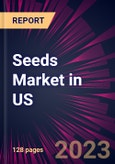Speak directly to the analyst to clarify any post sales queries you may have.
The report offers an up-to-date analysis regarding the current market scenario, the latest trends and drivers, and the overall market environment. The market is driven by growth in adoption of gm seeds in us, increase in government support through farm subsidies and financial aid, and rise in urban farming activities.
The seeds market in us is segmented as below:
By Product
- GM seeds
- Conventional seeds
By Type
- Grain seeds and oilseeds
- Fruits and vegetable seeds
- Others
By Geographical Landscape
- North America
The report on the seeds market in us covers the following areas:
- Seeds Market in US sizing
- Seeds Market in US forecast
- Seeds Market in US industry analysis
The study was conducted using an objective combination of primary and secondary information including inputs from key participants in the industry. The report contains a comprehensive market and vendor landscape in addition to an analysis of the key vendors.
The report presents a detailed picture of the market by the way of study, synthesis, and summation of data from multiple sources by an analysis of key parameters such as profit, pricing, competition, and promotions. It presents various market facets by identifying the key industry influencers. The data presented is comprehensive, reliable, and a result of extensive primary and secondary research. The market research reports provide a complete competitive landscape and an in-depth vendor selection methodology and analysis using qualitative and quantitative research to forecast accurate market growth.
Table of Contents
Executive Summary
The following companies are recognized as the key players in the seeds market in us: Ahern Agribusiness Inc., BASF SE, Bayer AG, Bejo Zaden BV, BHNSeed, Burrell Seed Growers LLC, Central Garden and Pet Co., China National Chemical Corp. Ltd., Emerald Seed Co., Fruition Seeds LLC, Great American Seed Up, Johnnys Selected Seeds, Kagome Co. Ltd., Mars Inc., Origene Seeds Ltd., Renees Garden Seeds, Sakata Seed Corp., Takii and Co. Ltd., The Living Seed Co. LLC, and W. Atlee Burpee and Co..Commenting on the report, an analyst from the research team said: "The latest trend gaining momentum in the market is growth in consolidation in seeds market in us."
According to the report, one of the major drivers for this market is the growth in adoption of gm seeds in us.
The study was conducted using an objective combination of primary and secondary information including inputs from key participants in the industry. The report contains a comprehensive market and vendor landscape in addition to a SWOT analysis of the key vendors.
Companies Mentioned (Partial List)
A selection of companies mentioned in this report includes, but is not limited to:
- Ahern Agribusiness Inc.
- BASF SE
- Bayer AG
- Bejo Zaden BV
- BHNSeed
- Burrell Seed Growers LLC
- Central Garden and Pet Co.
- China National Chemical Corp. Ltd.
- Emerald Seed Co.
- Fruition Seeds LLC
- Great American Seed Up
- Johnnys Selected Seeds
- Kagome Co. Ltd.
- Mars Inc.
- Origene Seeds Ltd.
- Renees Garden Seeds
- Sakata Seed Corp.
- Takii and Co. Ltd.
- The Living Seed Co. LLC
- W. Atlee Burpee and Co.








